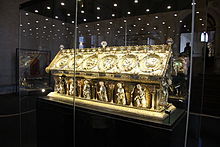- Reliquary of St. Maurus
-
St. Maurus reliquary is a Romanesque reliquary exhibited in the castle of Bečov nad Teplou in the west of the Czech Republic. It is considered to be the second most important historical artefact in the Czech territory after the Czech Crown Jewels.[1]
The reliquary was created for the monastery of Florennes (Belgium) in the first quarter of the 13th century to hold the purported skeletal remains of St. Maurus, St. John the Baptist, and St. Timothy.[2] The wooden core is covered with gilded silver plate with many statuettes, reliefs, filigree decorations and gems. After the sacking of Florennes the reliquary was placed in the local church and later bought by Duke Alfred de Beaufort-Spontin in 1838. The Duke restored the damaged artifact and loaned it to the Brussels Exhibition of 1885. By 1888, the Beauforts transported it to their castle estate in Bečov.[2]
The house of Beaufort cooperated with the Nazi Party during World War II and was forced to leave the country in 1945.[2] Shortly before the end of the war, the reliquary was buried beneath the floor in the chapel and effectively forgotten. In 1984, an American businessman Danny Douglas approached Czechoslovak authorities (Embassy in Vienna) with an offer to pay 250,000 USD for the right to excavate and export abroad an otherwise unidentified object “which nobody here misses anyway”. From the fragments of information provided, the authorities initiated a search operation to verify the nature of the "object" and find it.[2] This operation was led by JUDr. František Maryška the head of federal investigation bureau at that time. From the fragments of information provided his team was able to narrow the investigation to 5 possible locations and 3 weeks before the business was to be performed they were able to identify that the "object" must be located in Bečov Castle or surrounding area. Police officers arrived to the location with many man and with metal detectors and were searching all the surroundings digging several holes in garden and outside the castle. Since the weather was bad and Douglas was not worried about snow or frozen earth they concluded that the object must be inside. So they started with the search inside on places where a hidden room was anticipated or where such an object might fit. When searching the floor in the old castle chapel they identified that a large metallic object was below and after removing the wooden boards they discovered the St. Maurus reliquary on 5 November 1985.
Restoration
The reliquary had decayed significantly after its decades of burial. The Czech authorities, after refusing to allow the relic's export and working to resolve ownership disputes, began an extensive restoration which lasted from 1991 by restorers from Prague's Museum of Applied Arts and preservation experts from Aachen (Germany). The restoration was complete in 2002 and the artifact was then returned to Bečov.[2] The shrine has since been on public display in both the Becov Castle and Prague Castle.
Description
The reliquiary is a large chasse, or house-shaped casket, with a wooden structure covered by silver-gilt plates, with 12 small statues of saints, elaborate romanesque metalwork ornamentation, and a number of gems, including engraved gems from earlier periods.[2]
The golden vessel is presumed to house some remains attributed to St. John the Baptist, Saint Timothy, with remains of Saint Maurus added later.[2]
References
- ^ Saint Maur and Cognac
- ^ a b c d e f g "The shrine St Maurus" zamek-becov.cz Retrieved December 30, 2010.
Categories:- Mosan art
- Reliquaries
- Silver-gilt objects
Wikimedia Foundation. 2010.

